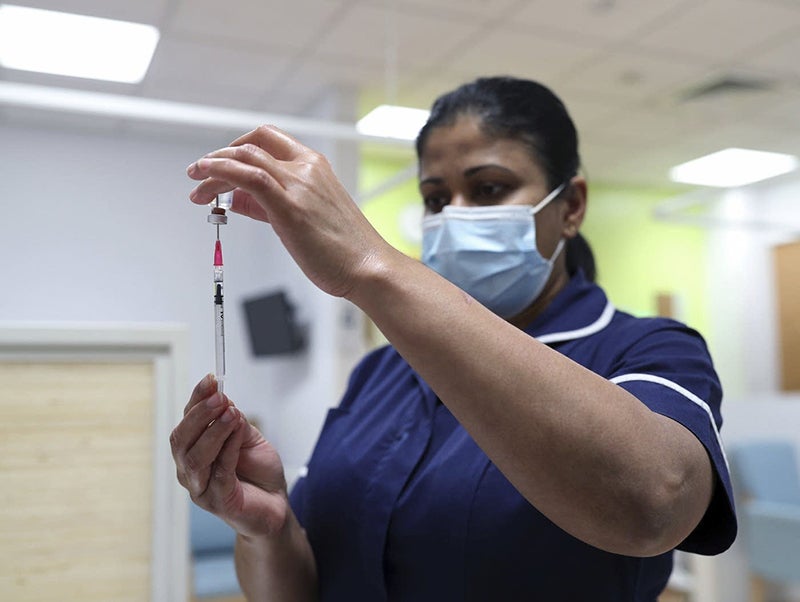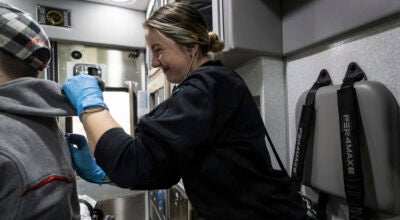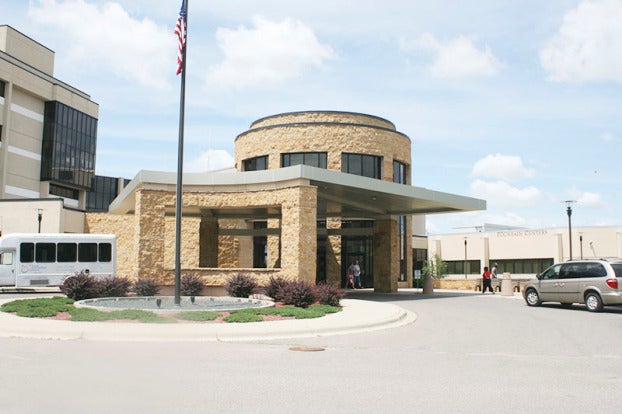Minnesota presents plan for COVID-19 vaccine
Published 4:30 pm Tuesday, December 8, 2020

- A nurse at the Royal Free Hospital simulates the administration of the Pfizer vaccine to support staff training ahead of the rollout in London earlier in December. - Yui Mok/pool photo via AP/via MPR News
|
Getting your Trinity Audio player ready...
|
By Dan Kraker, Minnesota Public Radio News
As COVID-19 cases continue to surge across Minnesota, with the state’s death toll climbing above 4,000 people this week, Gov. Tim Walz offered a ray of hope Tuesday as he laid out a distribution plan for the expected arrival of a coronavirus vaccine.
Frontline health care workers and residents of long-term care facilities will be the first to receive the vaccine as early as this month.
But the ramp up of vaccine availability will be slow. Minnesota expects to receive fewer than 200,000 doses of vaccine during the first three weeks of roll-out.
“We would expect, if everything goes according to plan, the week of Dec. 21, that people could start vaccinating. Perhaps an early Christmas present,” said Kris Ehresmann, the Minnesota Department of Health’s infectious disease and control director.
Gov. Walz and public health officials urged people to be patient, and to remain vigilant, and to continue to practice protective measures like mask wearing and social distancing.
“We’re committed to getting the vaccine to every Minnesotan that wants one and should be vaccinated, said health commissioner Jan Malcolm. “In the meantime we ask for your patience, and your continued collective work and individual work to do the things we know will slow the spread of this virus.”
Who will get the vaccine first?
Health care workers working at hospitals and long-term care facilities, and residents of long-term care facilities, including nursing homes and skilled nursing facilities, will be the first to get the vaccine.
That follows a recommendation made last week by a federal advisory group to the Centers for Disease Control and Prevention, which voted during an emergency meeting to prioritize those two high-priority groups once a vaccine is approved.
Because supplies of the vaccines will be ramped up slowly, not all people in the first tier will be able to get vaccinated immediately. So state officials have divided that group into different levels of priority to receive the vaccine.
The highest priority is people who have direct contact with individuals who have COVID-19, including staff working in hospital COVID-19 units and at skilled nursing facilities, workers testing people for COVID-19 and people administering the vaccine.
The second priority is other health care personnel in hospitals, urgent care centers, and staff and residents in assisted living facilities.
The third priority includes all remaining health care personnel.
Health Commissioner Jan Malcolm said it could be six months before the vaccine is in wide distribution.
How soon will the vaccines be available?
People in Minnesota could begin getting vaccinated as early as the week of Dec. 21, if as expected the U.S. Food and Drug Administration grants an emergency use authorization later this week to Pfizer, the company furthest along in developing a vaccine.
A decision on the Pfizer vaccine is expected Dec. 10. Kris Ehresmann, the Minnesota Department of Health’s infectious disease and control director, estimated it will be ready to begin to be administered in the state around Dec. 21.
People could also begin to receive a second coronavirus vaccine, manufactured by Moderna, that’s being considered for emergency use authorization by the FDA, as early as the week of Dec. 21.
Because states are being allocated limited quantities of the vaccine to start, Minnesota public health officials have been working with a group of physicians, hospital representatives, pharmacies and long-term care administrators to develop a distribution plan for the vaccine tailored to the state’s needs.
Nationwide, as many as 40 million doses could be available by the end of December, with 5-10 million available each week after that.
How many vaccines will Minnesota get?
Over a three-week period beginning the week of Dec. 14, the state expects to receive 183,400 vaccine doses. That’s according to an expected initial delivery schedule based on the most recent forecast from the federal government.
In the first week, Minnesota expects to receive 46,800 doses of the Pfizer vaccine. In the second and third weeks, the state expects to receive 94,800 and 41,800 doses of the Moderna vaccine, but none of the Pfizer vaccine.
The initial 183,000 doses is for that many people. The vaccine developers are holding back the second dose until they are needed.
Which vaccine will Minnesotans receive?
A vaccine being developed by Pfizer is the first vaccine candidate in line to be approved. A second vaccine, manufactured by Moderna, would also be available in the state if it receives federal emergency use authorization.
Both vaccines need to be kept cold, especially the Pfizer vaccine, which needs to be stored at a temperature of at least minus 70 degrees Celsius. That could pose a logistical issue for rural areas of the state, where cold storage space to protect the vaccine may be scarce. Pfizer says it has developed its own packaging designed to safely store the vaccine for a few weeks using dry ice.
When will others be eligible to receive the vaccine?
Essential workers — including teachers, first responders and others — will be next in line for the vaccine after health care workers and long-term care residents.
People with underlying health conditions who are more likely to become severely ill if they contract COVID-19 are also likely to be prioritized for receiving the vaccine, along with people 65 and older.
Where will I be able to get vaccinated?
Health care workers will be vaccinated at their workplace; likewise, long-term care residents will also receive the vaccination where they live.
Once the vaccines are distributed more widely, they will be administered in a variety of settings, from pharmacies and doctors’ offices to health clinics and special vaccination sites.
Will I need to get two shots?
Yes, at least at first. Both the Pfizer and Moderna vaccinations require two doses within weeks of each other. You must get both doses from the same developer. Public health officials are considering strategies to make sure people who get their first shot come back for their second on time.
Other vaccines that are currently undergoing trials could do away with the two-dose requirement, including a vaccine candidate being developed by Johnson & Johnson. But it’s unclear if or when a one-dose vaccine will be approved.
Are these vaccines safe?
The speed with which these vaccines have been developed — 11 months, compared to the several years it has taken vaccines in the past to be approved — has created a ripe environment for concerns over safety.
The process has been accelerated in part because the companies making the vaccines have recruited clinical trial participants more quickly, and have also shown federal regulators their vaccine testing data in real-time instead of after the testing process is complete.
Those trials have still been subject to the same safety evaluations as any other vaccine, said Ehresmann. The manufacturers have to show how their vaccine studies were designed, how they got their data, and their results.
As with all vaccines, some people who are inoculated will have adverse reactions. A reporting system to track those reactions will be launched as soon as the vaccines are deployed.
How effective are the vaccines?
Studies have shown that both the Pfizer and Moderna vaccines are about 95% effective after both doses are administered.
Ehresmann said it will take about six weeks from an initial vaccination for adults to develop resistance to COVID-19.



